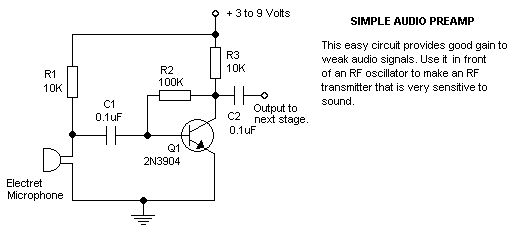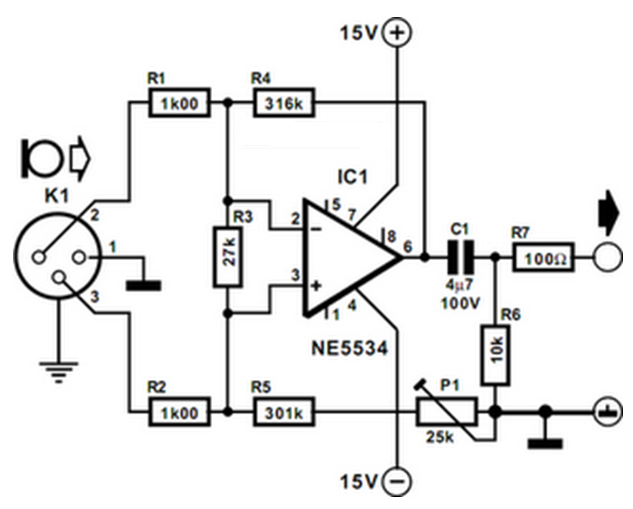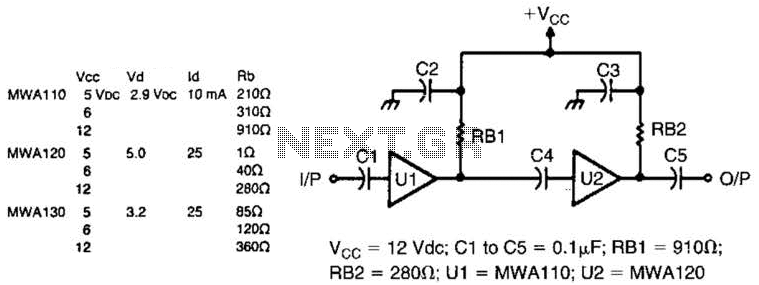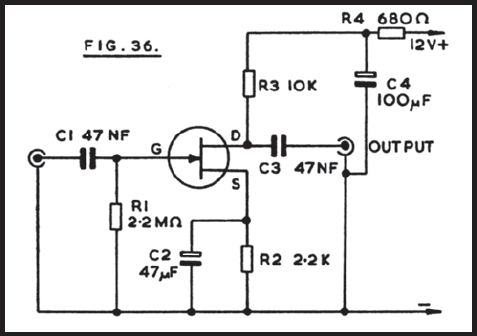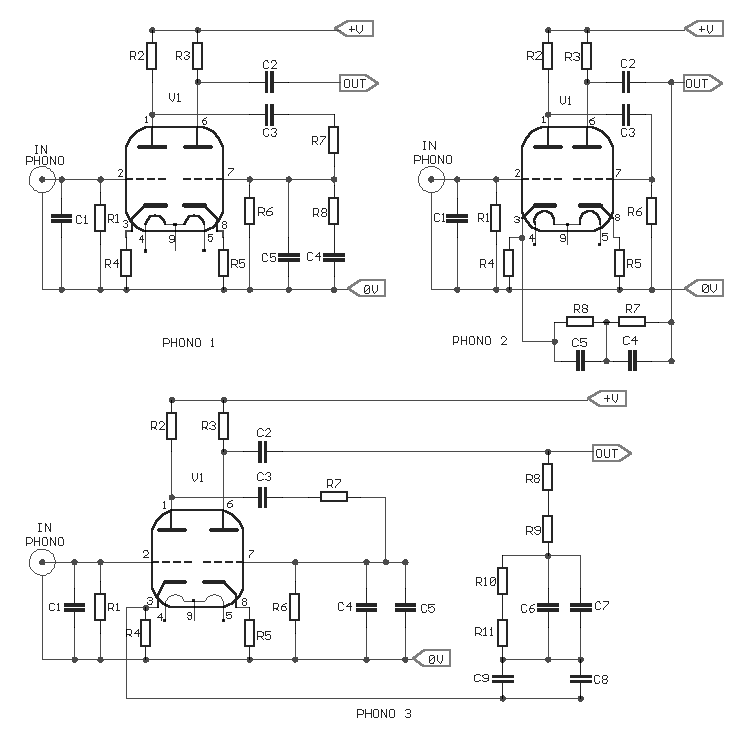
JFET PREamp
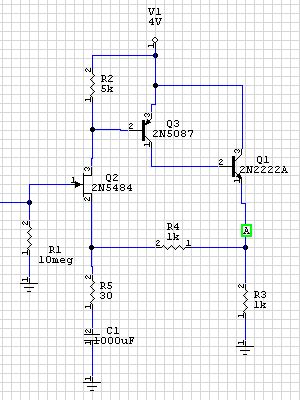
The input transistor Q2 is an N-channel JFET. Each specific JFET establishes a particular output bias voltage, necessitating the selection of the JFET from various devices to achieve the desired bias value. Fortunately, due to the low current involved, suitable devices can be sourced from a broad range of types. JFETs also differ in terms of gain and noise levels, thus optimal performance requires careful selection in this regard. However, aside from exceptionally poor noise performance in certain devices, a wide variety of JFETs operate in a surprisingly similar manner. The input resistor R1 pulls the JFET gate to ground potential, thereby reverse-biasing the FET. Its value should be at least ten times the signal source impedance, though it could be as high as 100 megohms if beneficial. Larger resistors do introduce slightly more Johnson noise, but this is typically mitigated by a low-impedance signal source. The second transistor Q3 is a bipolar PNP. One might assume it should be a low-noise, low-current linear device, but in practice, this does not significantly impact performance. A variety of PNP devices can be utilized without altering the circuit and with minimal differences in operation. The resistor across the base-emitter junction of the PNP, R2, sets the standing or quiescent current for the input transistor. The PNP operates at the knee of turn-on, approximately 0.6V. The suggested value of 5K allows about 0.6/5k = 120µA to flow through the JFET before the PNP begins to turn on, which subsequently increases the output voltage and starts to turn off the input transistor. Since feedback maintains nearly constant current through the input transistor, resistor R2 can be regarded as a simple form of constant-current source. The low operating current enables the JFET gate to function at a bias voltage considerably lower than the specified Gate-Source Cutoff Voltage, thus accommodating a wide range of devices. The optimal JFET current for minimal noise can be verified by adjusting the PNP base-emitter resistor value. The current in the second transistor is generally much lower than that in the input transistor, which typically reduces the expected gain from the second transistor. The PNP load resistor is absent. The original design, along with every other design observed, included a load resistor to ground. However, omitting that resistor appeared to yield greater gain and reduced noise. The current in the second transistor seemingly operates against a larger load resistance to generate a higher voltage output. The results appear largely independent of device characteristics, and the circuit without the resistor simulates effectively. The output transistor Q1 is a bipolar NPN configured as an emitter-follower, and it is also noncritical. For instance, employing a high-gain Darlington device increased the open-loop gain by only 3dB, with even less effect on the closed-loop gain. The emitter-follower output decreases the maximum positive output by 0.6V. Therefore, if the circuit is expected to function effectively with a 4V supply (from a 9V battery nearing end-of-life), the maximum output is limited to 3.4V. Ideally, the output bias should be around 1.7V, although this can be adjusted with minimal impact. The output pull-down resistor R3 supplies the energy for negative-going portions of the audio output. Since the emitter-follower can only source current, this resistor defines the maximum load that can be driven in a negative direction. Consequently, it should be small, typically less than one-tenth the input resistance of the subsequent stage. However, this resistor also significantly contributes to power consumption, thus it should be large. If the output bias is set (by selecting the FET) at 1.5V, a resistor value of 1K will draw approximately 1.5mA, which the battery must supply whenever the preamp is operational. The expected battery life for a new 9V alkaline battery under a 2mA load is approximately 330 hours (or about 13.75 days). Reducing current consumption enhances battery longevity.
The circuit described is a low-noise preamplifier utilizing an N-channel JFET as the input stage, followed by a PNP transistor for signal amplification and an NPN transistor configured as an emitter follower for output. The JFET's selection is crucial, as it determines the output bias voltage, which is essential for optimal performance. The input resistor R1 plays a significant role in ensuring the JFET operates in its desired region by reverse-biasing its gate, while R2 establishes the quiescent current for the PNP transistor, allowing for stable amplification.
The feedback mechanism in the circuit ensures that the current through the input transistor remains nearly constant, which is vital for maintaining performance across varying signal levels. The omission of the PNP load resistor enhances the circuit's gain and reduces noise, demonstrating the importance of component selection and configuration in circuit design.
The output stage, utilizing an emitter-follower configuration, provides a buffered output while limiting the maximum output voltage swing. The output pull-down resistor R3 is essential for defining the load characteristics and impacts power consumption, highlighting the trade-off between performance and efficiency in battery-operated applications. The design effectively balances these factors to achieve a reliable and efficient low-noise audio preamplifier suitable for various applications.The input transistor Q2 is an N-channel JFET. Each particular JFET sets a particular output bias voltage, so the JFET must be selected from among multiple devices for the desired bias value. Fortunately, due to the low current involved, desirable devices can come from a wide range of device types.
JFETs also vary with respect to gain and noise lev el, so best operation requires some selection there as well. However, other than exceptionally bad noise in particular devices, a wide range of JFETs function surprisingly similarly. The input resistor R1 just drags the JFET gate to ground potential and so reverse-biases the FET. The value should be at least 10x the signal source impedance, but probably could be as high as 100 megohms, if that was useful for some reason.
Larger resistors do produce somewhat more Johnson noise, but that is normally "shunted" or "shorted out" by a low-impedance signal source. The second transistor Q3 is a bipolar PNP. One might think to make it a low-noise low-current-linear device, but in practice that does not seem to matter much.
Many different PNP devices can be used with no circuit change and remarkably little difference. The resistor across the base-emitter junction of the PNP R2 sets the "standing" or "quiescent" current for the input transistor. The PNP operates on the "knee" of turn-on, at about 0. 6V. The recommended value of 5K allows about 0. 6/5k = 120uA to flow through the JFET before the PNP starts to turn on, which then increases the output voltage and starts to turn off the input transistor.
Since feedback keeps the current through the input transistor almost constant, resistor R2 can be seen as a particularly simple form of constant-current source. The low operating current allows the JFET gate to operate at a bias voltage much lower than the specified "Gate-Source Cutoff Voltage, " thus making a wide range of devices usable.
The best JFET current for lowest noise can easily be checked by varying the PNP base-emitter resistor value. The current in the second transistor typically is much lower than in the input transistor. That typically reduces the gain we can expect from the second transistor. The PNP load resistor is missing. The original design, and every other design I have seen, had a load resistor to ground. However, removing that resistor seemed to produce more gain and less noise. The current in the second transistor apparently works against a larger load resistance to produce a larger voltage result.
The results seem fairly independent of device characteristics, and the circuit without the resistor simulates just fine. The output transistor Q1 is a bipolar NPN as an emitter-follower, and is also noncritical. For example, a high-gain Darlington device increased the open-loop gain by all of 3dB, and had even less effect on the closed-loop gain.
The emitter-follower output does reduce the maximum positive output by 0. 6V. So if we expect to work well with a 4V supply (a 9V battery at end-of-life), we have a maximum output of 3. 4V. That means, ideally, we would want the output bias to be around 1. 7V, although we can vary that with minimal impact. The output pull-down resistor R3 provides the energy for negative-going parts of the audio output. Since the emitter-follower can only source current, this resistor will define the maximum load which can be driven in a negative direction.
Thus, it should be small, typically under 1/10 the input resistance of the next stage. However, this resistor also is one of the main contributors to power consumption, so it also should be large. If the output bias is set (by selecting the FET) at 1. 5V, a value of 1K will sink about 1. 5mA which the battery must then supply whenever the preamp is operating. Battery life for a new 9V alkaline battery with a 2mA load should be about 330 hours (13. 75 days or about 2 weeks) of continuous operation. Less current means better battery life. Po 🔗 External reference
The circuit described is a low-noise preamplifier utilizing an N-channel JFET as the input stage, followed by a PNP transistor for signal amplification and an NPN transistor configured as an emitter follower for output. The JFET's selection is crucial, as it determines the output bias voltage, which is essential for optimal performance. The input resistor R1 plays a significant role in ensuring the JFET operates in its desired region by reverse-biasing its gate, while R2 establishes the quiescent current for the PNP transistor, allowing for stable amplification.
The feedback mechanism in the circuit ensures that the current through the input transistor remains nearly constant, which is vital for maintaining performance across varying signal levels. The omission of the PNP load resistor enhances the circuit's gain and reduces noise, demonstrating the importance of component selection and configuration in circuit design.
The output stage, utilizing an emitter-follower configuration, provides a buffered output while limiting the maximum output voltage swing. The output pull-down resistor R3 is essential for defining the load characteristics and impacts power consumption, highlighting the trade-off between performance and efficiency in battery-operated applications. The design effectively balances these factors to achieve a reliable and efficient low-noise audio preamplifier suitable for various applications.The input transistor Q2 is an N-channel JFET. Each particular JFET sets a particular output bias voltage, so the JFET must be selected from among multiple devices for the desired bias value. Fortunately, due to the low current involved, desirable devices can come from a wide range of device types.
JFETs also vary with respect to gain and noise lev el, so best operation requires some selection there as well. However, other than exceptionally bad noise in particular devices, a wide range of JFETs function surprisingly similarly. The input resistor R1 just drags the JFET gate to ground potential and so reverse-biases the FET. The value should be at least 10x the signal source impedance, but probably could be as high as 100 megohms, if that was useful for some reason.
Larger resistors do produce somewhat more Johnson noise, but that is normally "shunted" or "shorted out" by a low-impedance signal source. The second transistor Q3 is a bipolar PNP. One might think to make it a low-noise low-current-linear device, but in practice that does not seem to matter much.
Many different PNP devices can be used with no circuit change and remarkably little difference. The resistor across the base-emitter junction of the PNP R2 sets the "standing" or "quiescent" current for the input transistor. The PNP operates on the "knee" of turn-on, at about 0. 6V. The recommended value of 5K allows about 0. 6/5k = 120uA to flow through the JFET before the PNP starts to turn on, which then increases the output voltage and starts to turn off the input transistor.
Since feedback keeps the current through the input transistor almost constant, resistor R2 can be seen as a particularly simple form of constant-current source. The low operating current allows the JFET gate to operate at a bias voltage much lower than the specified "Gate-Source Cutoff Voltage, " thus making a wide range of devices usable.
The best JFET current for lowest noise can easily be checked by varying the PNP base-emitter resistor value. The current in the second transistor typically is much lower than in the input transistor. That typically reduces the gain we can expect from the second transistor. The PNP load resistor is missing. The original design, and every other design I have seen, had a load resistor to ground. However, removing that resistor seemed to produce more gain and less noise. The current in the second transistor apparently works against a larger load resistance to produce a larger voltage result.
The results seem fairly independent of device characteristics, and the circuit without the resistor simulates just fine. The output transistor Q1 is a bipolar NPN as an emitter-follower, and is also noncritical. For example, a high-gain Darlington device increased the open-loop gain by all of 3dB, and had even less effect on the closed-loop gain.
The emitter-follower output does reduce the maximum positive output by 0. 6V. So if we expect to work well with a 4V supply (a 9V battery at end-of-life), we have a maximum output of 3. 4V. That means, ideally, we would want the output bias to be around 1. 7V, although we can vary that with minimal impact. The output pull-down resistor R3 provides the energy for negative-going parts of the audio output. Since the emitter-follower can only source current, this resistor will define the maximum load which can be driven in a negative direction.
Thus, it should be small, typically under 1/10 the input resistance of the next stage. However, this resistor also is one of the main contributors to power consumption, so it also should be large. If the output bias is set (by selecting the FET) at 1. 5V, a value of 1K will sink about 1. 5mA which the battery must then supply whenever the preamp is operating. Battery life for a new 9V alkaline battery with a 2mA load should be about 330 hours (13. 75 days or about 2 weeks) of continuous operation. Less current means better battery life. Po 🔗 External reference
